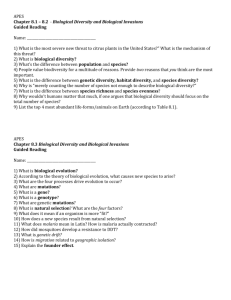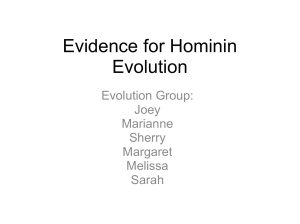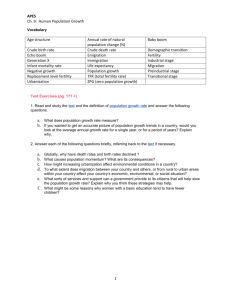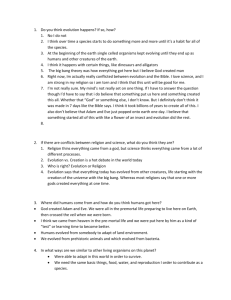BLS APES Summer Assignment Draft Edited
advertisement
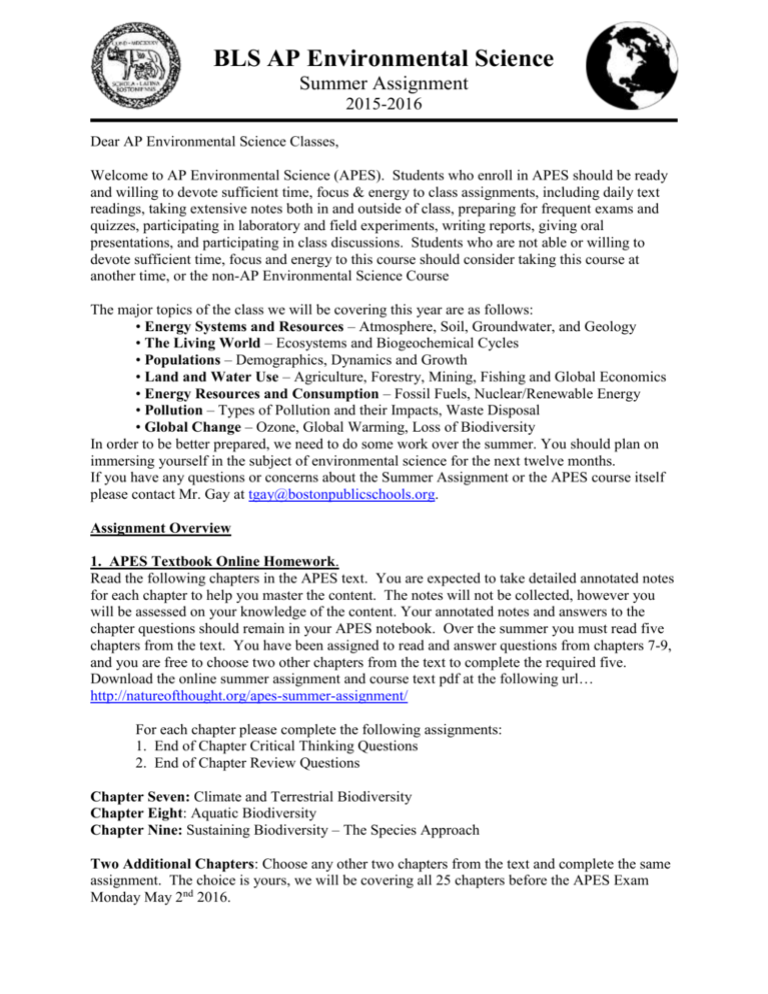
BLS AP Environmental Science Summer Assignment 2015-2016 Dear AP Environmental Science Classes, Welcome to AP Environmental Science (APES). Students who enroll in APES should be ready and willing to devote sufficient time, focus & energy to class assignments, including daily text readings, taking extensive notes both in and outside of class, preparing for frequent exams and quizzes, participating in laboratory and field experiments, writing reports, giving oral presentations, and participating in class discussions. Students who are not able or willing to devote sufficient time, focus and energy to this course should consider taking this course at another time, or the non-AP Environmental Science Course The major topics of the class we will be covering this year are as follows: • Energy Systems and Resources – Atmosphere, Soil, Groundwater, and Geology • The Living World – Ecosystems and Biogeochemical Cycles • Populations – Demographics, Dynamics and Growth • Land and Water Use – Agriculture, Forestry, Mining, Fishing and Global Economics • Energy Resources and Consumption – Fossil Fuels, Nuclear/Renewable Energy • Pollution – Types of Pollution and their Impacts, Waste Disposal • Global Change – Ozone, Global Warming, Loss of Biodiversity In order to be better prepared, we need to do some work over the summer. You should plan on immersing yourself in the subject of environmental science for the next twelve months. If you have any questions or concerns about the Summer Assignment or the APES course itself please contact Mr. Gay at tgay@bostonpublicschools.org. Assignment Overview 1. APES Textbook Online Homework. Read the following chapters in the APES text. You are expected to take detailed annotated notes for each chapter to help you master the content. The notes will not be collected, however you will be assessed on your knowledge of the content. Your annotated notes and answers to the chapter questions should remain in your APES notebook. Over the summer you must read five chapters from the text. You have been assigned to read and answer questions from chapters 7-9, and you are free to choose two other chapters from the text to complete the required five. Download the online summer assignment and course text pdf at the following url… http://natureofthought.org/apes-summer-assignment/ For each chapter please complete the following assignments: 1. End of Chapter Critical Thinking Questions 2. End of Chapter Review Questions Chapter Seven: Climate and Terrestrial Biodiversity Chapter Eight: Aquatic Biodiversity Chapter Nine: Sustaining Biodiversity – The Species Approach Two Additional Chapters: Choose any other two chapters from the text and complete the same assignment. The choice is yours, we will be covering all 25 chapters before the APES Exam Monday May 2nd 2016. 2. APES Current Events. In environmental science, you should be familiar with environmental issues that are important to our local community, our state, our country, and our world. Over the course of the summer, you must read and collect 5 articles, published since June 1, 2014, relating to environmental issues. The articles MUST be drawn from the topic list below, making sure that at least 5 different topics are represented. Label each summary according to its topic. For example, if your first article and summary is about overpopulation, be sure your heading includes, "Overpopulation". Current Event Topics 1. Human population growth 10. CO2 and global warming 2. Transgenic species 11. Recycling or another aspect of waste management (garbage) 3. Non‐native (invasive) species 12. Nature Conservancy, Sierra Club, World 4. Food production, food safety Wildlife Fund, or similar NGO 5. Fossil fuels (coal, oil, natural gas) 13. Overfishing, overhunting 6. Renewable resources (solar, wind, 14. Deforestation geothermal, hydroelectric, etc.) 15. Ozone depletion 7. Nuclear Energy 16. Legislation or International Treaty dealing 8. Air quality with an environmental issue 9. Water quality (surface or groundwater) Article Analysis: Include all of the following components to your write-up and clearly identify each section. 1. Points of View: Does the article give two different points of view? Yes or No. If yes, what are they? 2. Bias: The order in which information is presented and the amount of text devoted to influencing a reader’s opinion is called bias. Is this article biased, and if so, which way is the article biased (slanted)? In your opinion does the author give a positive, negative or neutral view of the environmental science topic? Explain. 3. Science: What did the authors study? What type of scientific analysis was performed? What does the data say, and what do the authors conclude about their study? 4. Your Perspective: State your perspective on this news article based on your personal knowledge of the topic and your reading of this article. 5. Affect on You: How does this topic affect you, or how does it relate to your life? Your article sources must be from scientific publications. Primary Scientific Sources: Science, Nature, PLOS One, PNAS. Secondary Scientific Sources: National Geographic, Discover Magazine, Scientific American. Some helpful url’s are provided below for open access science journal articles. http://www.sciencedirect.com/science/jrnlallbooks/all/open-access https://doaj.org/subjects https://www.plos.org/ Include a Cover sheet and a Table of Contents in which you number the articles and list; the topic, title, source, and date of each article. 3. APES Law Review Find the following for each of the laws and/or treaties and construct a table containing all of the information requested below a) Name, Draft Year, Amendment Years, International or National b) Description of Function; Environmental Issues Affected c) Agency or Group Responsible for Regulation and Enforcement (i.e. United Nations, Department of Interior, EPA, etc.) 1. Antarctic Treaty 2. Cairo Conference on Population and Development 3. Clean Air Acts 4. Comprehensive Environmental Response, Compensation Liability Act (CERCLA) 5. Convention of Climate Change and the Kyoto Protocol 6. Convention of Ozone Depletion and the Montreal Protocol 7. Convention on International Trade in Endangered Species (CITES) 8. Law of the Sea Convention (LOSC) 9. Declaration of the Conference on the Human Environment (Stockholm Declaration) 10. Endangered Species Act 11. Energy Policy Act 12. Federal Food, Drug, and Cosmetic Act (FFDCA) 13. Federal Insecticide, Fungicide and Rodenticide Act (FIFRA) 14. Food Quality Protection Act of 1996 (FQPA) 15. Lacey Act 16. Migratory Bird Hunting Stamp Act 17. NEPA (National Environmental Policy Act) 18. Rio Earth Summit 19. Surface Mining Control and Reclamation Act 20. Taylor Grazing Act 21. The Emergency Planning & Community RightToKnow Act (EPCRA) 22. The Occupational Safety and Health Act (OSHA) 23. The Oil Pollution Act of 1990 (OPA) 24. The Resource Conservation and Recovery Act (RCRA) 25. The Safe Drinking Water Act (SDWA) 26. Toxic Substances Control Act 27. U.S. Clean Water Act 28. Wild and Scenic Rivers Act 29. Wilderness Act 4. APES Math Review. Prerequisite Basic Mathematical Skills You should also be prepared to perform mathematical calculation WITHOUT USING A CALCULATOR. Sometimes these calculations are fairly simple and you can complete the problems in your head. The APES exam requires that you SHOW ALL WORK for credit for the calculations on the free-response questions. This work is designed to assess your skills for the type of calculations you will encounter on the exam. Read through the following information and complete the problems on a separate piece of paper. I encourage you to use dimensional analysis and to refrain from using a calculator to solve these problems because you will not be using a calculator in class. This will NOT BE GRADED; however, there will be an assessment in September of 2015. Please visit the following url’s from Kahn Academy to review and master each mathematical concept. These calculations are integral to the course, so it is important you understand each method completely before starting the APES course. Percentage https://www.khanacademy.org/math/pre-algebra/decimals-pre-alg/percent-intro-prealg/e/finding_percents Scientific Notation https://www.khanacademy.org/math/algebra-basics/core-algebra-exponent-expressions/algebrafoundations-scientific-notation Dimensional Analysis https://www.khanacademy.org/math/algebra/introduction-to-algebra/unitsalgebra/v/dimensional-analysis-units-algebraically Prefixes m (milli) c (cent) k (kilo) M (mega) G (giga) T (tera) =1/1000 =1/100 =1000 =1,000,000 =1,000,000,000 =1,000,000,000,000 =10-3 =10-2 =103 =106 =109 =1012 APES Practice Math Problems 1. A population of BUNNIES was 200. If the population grows by 15% in one year, how many bunnies will there be next year? 2. A population of 300 bunnies is decimated by coyotes. The population drops from 300 to 34 individuals. What percentage did the population decrease by? 3. One year there were 40 houses in a neighborhood and the next year there were 50. What percentage did the number of houses grow by? 4. Electricity costs 8 cents per kilowatt hour. In one month your house uses one megawatt hour of electricity. How much will your electric bill be? You will have to convert! 5. Your car gets 15 miles to the gallon and your friend’s car gets 25 miles to the gallon. You decide to go on a road trip to New York City, which is 300 miles away. If gas costs $4 per gallon and you decide to split the gas money in half, how much money will you save by driving your friend’s car instead of yours? 6. What is one million times one thousand? Show your work in scientific notation. 7. You go to a parking lot that is 10 miles wide and 30 miles long. If one inch of rain falls on this parking lot, how many cubic feet of rain fell on the parking lot? (convert all units to feet first) 8. How many significant digits are in 0.0345? 9. Convert 6,800 BTU’s to k-w-h. Look up info on the internet! 10. Convert 6m3 to cm3. 11. Convert 66,600 to scientific notation. 12. Convert 0.000789 to scientific notation. 13. Solve (2.0 x 1012) x (3.5 x 101) 14. Solve 3.5 x 105 divided by 5.0 x 103 15. Solve 2.456 x 105 + 6.0034 x 108 16. Solve 4.801 x 103 - 2.2 x 107 17. A landfill must include a plastic layer along the bottom and sides to protect the groundwater. The landfill will be 200 meters wide by 300 meters long by 20 meters deep, and will NOT have a plastic “lid”. How much plastic will be needed to line the landfill? 18. How many significant figures are in 66000? 19. How many significant figures are in 0.007040? 20. How many significant figures are in 20006.0? 21. How many significant figures are in 0.007? 22. Write one million in scientific notation. 23. Write 0.0015 in scientific notation. 24. Write 5878300 in scientific notation. 25. Write 0.015 in scientific notation. 26. Write 2.45 x 104 in regular notation. 27. Write 1.23456 x 107 in regular notation. 28. Write 2.34 x 10-4 in regular notation. 29. Write 46789 x 10-3 in regular notation. 30. A 100 square mile area of national Park is how many acres? How many hectares? 31. Twelve hundred metric tons of solid waste is how many kilograms? 32. The total amount of freshwater on Earth is estimated to be 3.73 x 108 km3. What would that be in cubic meters? 33. If you are traveling at 70 miles per hour, how many minutes would it take to drive 175 miles? 34. What is 20% of a $34.80 bill? 35. 300 million is what percent of 7 billion? 5. APES Planetary Boundaries Read the scientific article attached to the end of this handout titled “Planetary boundaries: Guiding human development on a changing planet”. After reading the article, answer the following questions to be handed in the first day of school. Planetary Boundaries; Guiding Human Development on a Changing Planet 1. How do the authors define the planetary boundaries framework? What is the impetus for creating this classification system? 2. What parameters are used to define the planetary boundaries? What does each category signify? (safe operating space, zone of uncertainty etc…) 3. How have the authors accounted for global and regional issues for each planetary boundary? 4. Which (3) of the nine boundaries are of most importance according to this study? Why is this? Please be specific. 5. Choose three of the nine planetary boundaries, and write a Claims Evidence Reasoning(CER) for each, citing at least three pieces of evidence to support each claim. Please remember to connect each claim to the appropriate scientific reasoning. • Claim: What claim can you make about the planetary boundary? (Make an argument) • Evidence: List three pieces of evidence from the article to support your claim. (observations or facts) • Reasoning: What scientific reasoning can you provide to support the claim? (why do you think your argument is valid?) Write out three of the following CER’s for each Boundary you choose. Planetary Boundary: Authors Claim: Evidence: 1. 2. 3. Reasoning: 6. How do the authors define “novel entities”? What role do these play in the planetary boundary analysis? 7. Which planetary boundaries are most important? What do the authors say about boundary hierarchy? 8. What is the relation of the planetary boundaries to society? 9. How do the planetary boundaries interact with one another? 10. If the stubbornness of society continues, and not much action is taken to address the planetary boundaries proposed in this paper, what will happen to the planet? Predict what the earth will be like if we continue moving forward with the status quo of inaction. Be specific. Which planetary boundary will be overloaded first? What are the repercussions of this? How will the earth change? How does society change? 6. APES: “Home” Movie Questions Home is a 2009 documentary by Yann Arthus-Bertrand. The film is almost entirely composed of aerial shots of various places on Earth. It shows the diversity of life on Earth and how humanity is threatening the ecological balance of the planet. Please watch this film over the summer and answer the following questions. This will NOT BE GRADED; however, there will be an assessment in September of 2015. Movie Link: https://www.youtube.com/watch?v=jqxENMKaeCU&feature=c4-videosIf you have trouble finding the film, search online for “Home” movie, Glenn Close (narrator) 1. Describe the conditions on early Earth. 2. What happened to the carbon that poisoned the atmosphere? 3. How did the agricultural revolution change the Earth? 4. How has Earth changed in the last 60 years since the use of oil has become more widespread? 5. What is most of the grain in the US used for? 6. What led to the dramatic decline in the biodiversity of agricultural crop species? 7. How many kilos of water does it take to produce 1 kilo of beef? 8. How have cars shaped the way housing is laid out in the US and other developed countries? 9. How much has the volume of international trade increased since 1950? 10. What are your thoughts on how the video portrays Dubai? Is it self-sustainable? 11. Rainforests are cut down to make farmland for which products/crops? 12. What makes the growth of Lagos different from how most other cities grow? 13. Where does the water from Greenland’s melting ice sheet go? 14. Why are the glaciers of mountains so important for the people in the lowlands? 15. What hope does the video offer at the end? This video project covers many topics that we will discuss in APES this year. Give three specific examples that are portrayed in the video about each of the APES concepts that are listed below: All living things are linked 1. 2. 3. Developed vs. Developing Countries 1. 2. 3. Human Innovation and Technology 1. 2. 3. The Carbon cycle 1. 2. 3. Climatic Balance 1. 2. 3. Shortage of Resources 1. 2. 3. After watching the film, what topics are you most looking forward to learning about this year? What questions do you have?

